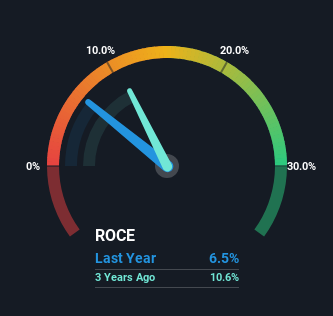Stock Analysis
- India
- /
- Metals and Mining
- /
- NSEI:STEELXIND
There's Been No Shortage Of Growth Recently For Steel Exchange India's (NSE:STEELXIND) Returns On Capital

If you're looking for a multi-bagger, there's a few things to keep an eye out for. Ideally, a business will show two trends; firstly a growing return on capital employed (ROCE) and secondly, an increasing amount of capital employed. This shows us that it's a compounding machine, able to continually reinvest its earnings back into the business and generate higher returns. So on that note, Steel Exchange India (NSE:STEELXIND) looks quite promising in regards to its trends of return on capital.
What Is Return On Capital Employed (ROCE)?
For those who don't know, ROCE is a measure of a company's yearly pre-tax profit (its return), relative to the capital employed in the business. The formula for this calculation on Steel Exchange India is:
Return on Capital Employed = Earnings Before Interest and Tax (EBIT) ÷ (Total Assets - Current Liabilities)
0.065 = ₹521m ÷ (₹12b - ₹3.8b) (Based on the trailing twelve months to September 2023).
So, Steel Exchange India has an ROCE of 6.5%. Ultimately, that's a low return and it under-performs the Metals and Mining industry average of 14%.
See our latest analysis for Steel Exchange India

Historical performance is a great place to start when researching a stock so above you can see the gauge for Steel Exchange India's ROCE against it's prior returns. If you want to delve into the historical earnings, revenue and cash flow of Steel Exchange India, check out these free graphs here.
What Does the ROCE Trend For Steel Exchange India Tell Us?
The fact that Steel Exchange India is now generating some pre-tax profits from its prior investments is very encouraging. About five years ago the company was generating losses but things have turned around because it's now earning 6.5% on its capital. And unsurprisingly, like most companies trying to break into the black, Steel Exchange India is utilizing 138% more capital than it was five years ago. This can tell us that the company has plenty of reinvestment opportunities that are able to generate higher returns.
On a related note, the company's ratio of current liabilities to total assets has decreased to 32%, which basically reduces it's funding from the likes of short-term creditors or suppliers. So shareholders would be pleased that the growth in returns has mostly come from underlying business performance.
Our Take On Steel Exchange India's ROCE
Long story short, we're delighted to see that Steel Exchange India's reinvestment activities have paid off and the company is now profitable. And with the stock having performed exceptionally well over the last five years, these patterns are being accounted for by investors. So given the stock has proven it has promising trends, it's worth researching the company further to see if these trends are likely to persist.
One more thing: We've identified 2 warning signs with Steel Exchange India (at least 1 which is significant) , and understanding them would certainly be useful.
While Steel Exchange India isn't earning the highest return, check out this free list of companies that are earning high returns on equity with solid balance sheets.
Valuation is complex, but we're helping make it simple.
Find out whether Steel Exchange India is potentially over or undervalued by checking out our comprehensive analysis, which includes fair value estimates, risks and warnings, dividends, insider transactions and financial health.
View the Free AnalysisHave feedback on this article? Concerned about the content? Get in touch with us directly. Alternatively, email editorial-team (at) simplywallst.com.
This article by Simply Wall St is general in nature. We provide commentary based on historical data and analyst forecasts only using an unbiased methodology and our articles are not intended to be financial advice. It does not constitute a recommendation to buy or sell any stock, and does not take account of your objectives, or your financial situation. We aim to bring you long-term focused analysis driven by fundamental data. Note that our analysis may not factor in the latest price-sensitive company announcements or qualitative material. Simply Wall St has no position in any stocks mentioned.
About NSEI:STEELXIND
Steel Exchange India
Steel Exchange India Limited manufactures and sells steel products in India.
Excellent balance sheet and overvalued.

